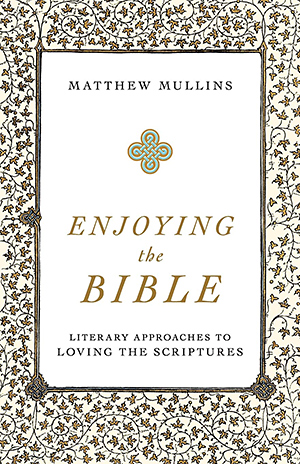Enjoying the Bible: Literary Approaches to Loving the Scriptures

Enjoying the Bible: Literary Approaches to Loving the Scriptures by Matthew Mullins. Baker. Grand Rapids, MI. 2021. Total pages: 194.
On a scale of 1-10, how much do you “love” reading Scripture? Do you experience guilt because you don’t seem to read it enough, or you don’t get enough out of your reading?
Mullins suggests the reason many people, religious or not, don’t read the Bible very much stems from their orientation of reading the Bible primarily for information. Treating it as a “how to” book or a recipe, it functions more like an instruction manual than a love letter. How often do you read instruction manuals? For most the answer would be, “When I need instruction on something specific.”
Such an orientation seems natural in Western thinking, going back to Enlightenment philosopher Rene Decartes (“I think, therefore I am”). With thinking as the starting point, even those who seek to make it practical by applying Scripture to our daily living still go to the Bible for information to apply—the instruction manual that can be user-friendly. Do you have instruction manuals you feel compelled to read every day? How often do you curl up in bed with an instruction manual?
The motivation to find the information God has in Scripture stems from a hermeneutic that needs to change. If the greatest commandment in the Bible remains: love the Lord your God with all you heart, soul, mind, and strength, and love your neighbor as yourself, do you find that happening when you read the Bible? Note that “mind” garners only one word in the greatest commandment, and it’s not even first in the list. A “love hermeneutic” might need to replace an “information hermeneutic.”
The author challenges the reader to start with poetry. That makes for a hard sell. Few people read poetry—less than seven percent in the past year according to a 2015 Washington Post article. More than twice that many are into knitting! How often do you read poetry? And yet one-third of the Bible is poetry. Some may argue that poetry doesn’t “tell it like it is.” Actually, it does, but you have to marinate as you read slowly. Sure, it takes your mind, but you have to engage your emotions, and that’s difficult when you don’t have much time and you need to just quickly glean the information.
Mullins persists with poetry, taking the reader through a process of understanding, appreciating, and engaging in poetry, using well-known poems and then various portions of Scripture. He argues that the Bible is literature, so reading primarily for information cheapens the art God shares with us. Without eliminating the information component of Scripture, he invites, cajoles, and lures the reader to experience more. Tap the imagination rather than filling in the blanks of a worksheet. Instead of looking for something new, read something familiar with new eyes and in new ways. Rather than a punch-list of reading the “year-through-the-Bible” with discipline, take a verse, a Psalm, a story, and invest your heart by adding your emotions to your thoughts.
Don’t panic out of fear this might turn into a free-for-all or a subjective “anything goes.” In reality, reading only for information probably short changes the meaning more than engaging the emotions would. What part of life is free of emotions? Yet reading for “truth” or a proposition rips a snippet of Scripture from the emotion that would provide more texture, meaning, and identification than a ready-made answer.
More than halfway through the book, the author took an excursion from Scripture and poetry to worship. He contrasted the sermon with music—sermon for thinking and music for feeling. Protestants, more than Catholics, allocate more time for preaching and lean toward information transmission. But music stirs the heart and soul. Think of how often a preacher turns to music to wrap up the sermon, anticipating that the Scriptural message needs more than words. The music might contain the same words as the sermon, but it goes deeper because it taps into more of the whole person than merely the mind.
The last five chapters provide helpful themes and practices to engage more of the whole person so the reader actually experiences joy in reading the Bible. This includes a new orientation that involves standing back to take in the whole scene, notice elements in the scene, ask questions, and wait on the text rather than simply reading through it so you can move onward. When reading a passage, come up with your own paraphrase—not to pass it along to others, but to wrestle with it yourself. Let this slow you down so you think more about the passage than a quick flyover with a shallow interpretation. Then read it for emotion—not merely the emotion it expresses, but the emotion it elicits in you as you stay with it. It may take time to settle into the main emotion, especially since it often includes colliding emotions. The actual forms of the literature can take you deeper than “the quick lesson” by considering parallelism, metaphors and similes, and more (metonymy, synecdoche, ambiguity, and narrative versus story).
Don’t expect a quick fix. Mullins invites the reader to simply start. Habits develop by repeated actions over time. Like a relationship with a person, we can gauge our relationship with the Bible and its author by considering how often our reading of Scripture results in worship, repeating the practice, and feeling comfortable spending time sitting in silence with God rather than moving on to other tasks after getting a bit of God-information for the day.
 |
Steve Case, PhD, reads through the Bible each year. Maybe he should focus on smaller portions to engage more of his heart. |
